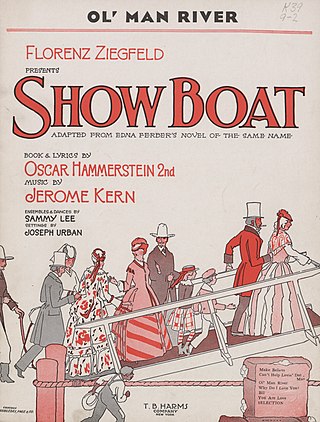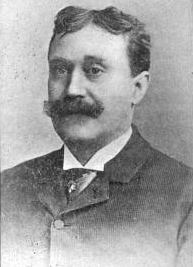
Paul Laurence Dunbar was an American poet, novelist, and short story writer of the late 19th and early 20th centuries. Born in Dayton, Ohio, to parents who had been enslaved in Kentucky before the American Civil War, Dunbar began writing stories and verse when he was a child. He published his first poems at the age of 16 in a Dayton newspaper, and served as president of his high school's literary society.

Louisiana Creole cuisine is a style of cooking originating in Louisiana, United States, which blends West African, French, Spanish, and Native American influences, as well as influences from the general cuisine of the Southern United States.

The cakewalk was a dance developed from the "prize walks" held in the mid-19th century, generally at get-togethers on Black slave plantations before and after emancipation in the Southern United States. Alternative names for the original form of the dance were "chalkline-walk", and the "walk-around". It was originally a processional partner dance performed with comical formality, and may have developed as a subtle mockery of the mannered dances of white slaveholders.
Guyanese culture reflects the influence of African, Indian, Amerindian, British, Portuguese, Chinese, Creole, and Dutch cultures. Guyana is part of the mainland Caribbean region. Guyanese culture shares a continuum with the cultures of islands in the West Indies.

Jambalaya is a savory rice dish of mixed origins that developed in the U.S. state of Louisiana apparently with African, Spanish, and French influences, consisting mainly of meat or seafood, and vegetables mixed with rice and spices.

Show Boat is a musical with music by Jerome Kern and book and lyrics by Oscar Hammerstein II. It is based on Edna Ferber's best-selling 1926 novel of the same name. The musical follows the lives of the performers, stagehands and dock workers on the Cotton Blossom, a Mississippi River show boat, over 40 years from 1887 to 1927. Its themes include racial prejudice and tragic, enduring love. The musical contributed such classic songs as "Ol' Man River", "Make Believe", and "Can't Help Lovin' Dat Man".

Abriea "Abbie" Mitchell Cook, also billed as Abbey Mitchell, was an American soprano opera singer. She performed the role of Clara in the premiere production of George Gershwin's Porgy and Bess in 1935, and was also the first to record "Summertime" from that musical.

William Mercer Cook, better known as Will Marion Cook, was an American composer, violinist, and choral director. Cook was a student of Antonín Dvořák. In 1919 he took his New York Syncopated Orchestra to England for a command performance for King George V of the United Kingdom, and tour. Cook is probably best known for his popular songs and landmark Broadway musicals, featuring African-American creators, producers, and casts, such as Clorindy, or The Origin of the Cake Walk (1898) and In Dahomey (1903). The latter toured for four years, including in the United Kingdom and United States.

In Dahomey: A Negro Musical Comedy is a landmark 1903 American musical comedy described by theatre historian Gerald Bordman as "the first full-length musical written and played by blacks to be performed at a major Broadway house." It features music by Will Marion Cook, book by Jesse A. Shipp, and lyrics by poet Paul Laurence Dunbar. It was written by Jesse A. Shipp as a satire on the American Colonization Society's back-to-Africa movement of the earlier nineteenth century.

African-American musical theater includes late 19th- and early 20th-century musical theater productions by African Americans in New York City and Chicago. Actors from troupes such as the Lafayette Players also crossed over into film. The Pekin Theatre in Chicago was a popular and influential venue.
Belizean Creoles, also known as Kriols, are a Creole ethnic group native to Belize.
Who dat? is an alternative pronunciation of the question "who's that?"

George Walker was an American vaudevillian, actor, and producer. In 1893, in San Francisco, Walker at the age of 20 met Bert Williams, who was a year younger. The two young men became performing partners. Walker and Williams appeared in The Gold Bug (1895), Clorindy (1898), The Policy Player (1899), Sons of Ham (1900), In Dahomey (1903), Abyssinia (1906), and Bandanna Land (1907). Walker married dancer Ada Overton, who later also was a choreographer.

George Washington Lederer was an American producer and director on Broadway from 1894 to 1931. He was the husband of actresses Reine Davies and Jessie Lewis and the father of Charles Lederer, Pepi Lederer, Glory Lederer and Geraldine Lederer.

Edward Everett Rice was an American musical theatre composer and producer active during the late 19th and early 20th centuries, known as a pioneer of American musical theatre, who introduced to Broadway Clorindy, a musical by African-American writers with African-American performers.

John William Isham was an American vaudeville impresario who was known for his Octoroons and Oriental America shows. These had their roots in traditional minstrel shows but included chorus girls, sketches and operas. They were part of the transition to the American burlesque shows of the early 20th century.

Saint Suttle, was an American composer and performer. Suttle was well known as a cakewalk artist and vaudeville performer in Chicago. An African American, he was a pioneering performer in early film of the late 19th-century.
The Darktown Follies were a series of musical revues staged in Harlem at the Lafayette Theatre from 1913 through 1916. All of the revue's creators were black, and it was one of the earliest musical revues to feature an all-black cast. Most of the music and lyrics written for the various reviews were created by J. Leubrie Hill and Will Vodery. Hill was also a major contributor to the musical books written for the revues, along with the writer Alex C. Rogers. Part of the age leading up to the Harlem Renaissance, the revue attracted diverse audiences from all over the city of New York. The theatre impresario Florenz Ziegfeld Jr. attended performances, and purchased some of the content of the Darktown Follies for use in his Broadway musical revue, Ziegfeld Follies.

Charlotte Louise Johnson, known as Lottie Williams and Lottie Thompson, was an American actress, singer, and dancer. A pioneering performer in African-American musical theater, she is best remembered for starring in several stage works with her second husband, Bert Williams, both on Broadway and in vaudeville. These included several musicals created by composer Will Marion Cook, lyricist Paul Laurence Dunbar, and the playwright Jesse A. Shipp; including Sons of Ham (1900), In Dahomey (1903), and Abyssinia (1906) among other works. In these musicals she portrayed mainly supporting character roles and was usually a featured singer and/or dancer. However, she portrayed the title role and the main protagonist in the Cook, Dunbar, and Shipp musical My Tom-Boy Girl (1905).















